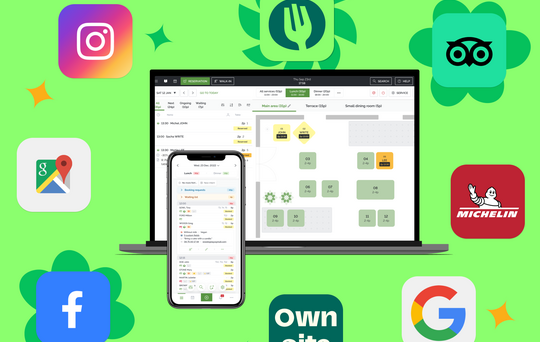How to Respond to Restaurant Reviews: 7 Effective Tips

- • Importance of Responding to Restaurant Reviews
- • Why Responding to Restaurant Reviews Matters
- • 1. Respond Quickly and Politely to All Reviews
- • 2. Express Gratitude in Your Responses
- • 3. Emphasise the Positive
- • Try TheFork Manager today
- • 4. Address Negative Reviews with Understanding and Facts
- • 5. Answer Everything
- • 6. A New Stage
- • 7. Make it personal
- • How to Respond to Negative Reviews Professionally
- • Building Customer Loyalty Through Review Responses
- • Viewing and replying to reviews
- • Empty tables and ever-increasing costs?
Feedback is incredibly valuable, especially for restaurants. Every day, you strive to improve the service and experience for your guests. While it’s important to listen and respond to every review, truly understanding your guests means putting yourself in their shoes.
Whether you’re wondering how to respond to good feedback or a seething comment, in this article we share 7 tips for addressing reviews effectively and some restaurant review response examples to make your life that little bit easier.
Importance of Responding to Restaurant Reviews
Encouraging and responding to restaurant reviews is crucial for maintaining a positive reputation and building customer trust. Timely, thoughtful responses show customers that you value their feedback and are committed to improving your services. In fact, 91% of people say local reviews shape their view of big brands, and a whopping 88% of consumers prefer restaurants that engage with their feedback1.
By actively engaging with reviews, whether positive or negative, you can enhance customer perception of your establishment and bolster your restaurant’s reputation in the community and online.
Why Responding to Restaurant Reviews Matters
So why respond to reviews? There are several important factors as to why you should always follow up any feedback left by your guests:
-
You ensure the guest feels heard. By responding promptly, you extend the personal touch of their dining experience, leaving a lasting impression and potentially encouraging a repeat visit.
-
You demonstrate your commitment to your guests. Other guests can also see your response to reviews, as your reply is visible to everyone who opens your restaurant page. This reflects your restaurant’s commitment to its guests and encourages new diners to make a reservation.
-
You have the opportunity to provide context. This is particularly helpful when addressing negative reviews. Explaining your side of the story, offering more details, or providing a possible solution can help clear up any misunderstandings and protect your reputation.
So, there are many reasons why responding to your guests’ online reviews is a smart move, and these responses can really enrich your restaurant page. With over 20 million reviews on TheFork, users are consistently active in regularly leaving reviews. One major advantage of TheFork Manager is that it provides a snapshot from the review page, helping you stay on top of things.
Now that the guest has finished dining and submitted their review, what should you keep in mind when responding?
1. Respond Quickly and Politely to All Reviews
Once guests leave their reviews, try to respond within 24 hours. That way, the memory of the experience and the restaurant is still fresh in their minds and shows that you value their opinion. Whether it’s a glowing compliment or a critical review, always respond with a friendly tone. Both types of feedback reviews are opportunities to engage, so be prompt and polite. For example:
"We’re so glad we could serve you last night! We hope to welcome you back soon and make your next visit even better."
2. Express Gratitude in Your Responses
The guest has taken time out of their day to leave a review, so it’s always good to thank them for that in your reply. If it's a happy restaurant review, it's nice that the person took the time to compliment you. If it’s a negative review, there may be valuable feedback to learn from. Regardless of the tone, thanking guests for their time and effort always puts you in a better position to foster goodwill. For instance:
"Thank you for coming to our restaurant and taking the time to write this post."
3. Emphasise the Positive
Did your restaurant receive a compliment? Great work! This is an ideal opportunity to boost your company's positive image. Highlight and acknowledge the appreciation, making sure to emphasise it for anyone else reading the review. Craft a response that reflects how happy you are to receive such kind words. Additionally, positive reviews are perfect for sharing on your own social media—what a great way to show your followers why people love your restaurant! For example:
"Thank you for leaving this fantastic review. Our waiters are so friendly, partly because we’re lucky to have guests like you. We hope to see you again soon!"
Try TheFork Manager today
4. Address Negative Reviews with Understanding and Facts
A negative review is never fun, but it often presents an opportunity to learn or address concerns with the right approach. Before you respond, take a deep breath and set aside any negative thoughts when reading criticism. Try to find out what happened at dinner and what the guest is talking about. Speak to your team to find out exactly how this guest was treated and then respond as promptly as possible using thoughtful, respectful language while thanking the guest. Consider saying something like:
"Thank you for your message. It’s true that it was a noisy evening as we had a large reservation around the same time. We’re sorry that we couldn't offer you another table, but we’ll definitely consider this for future seating to provide a quieter dining experience.”
5. Answer Everything
It‘s always best to respond to each individual point the guest has mentioned in their review. This way anyone who reads the review at a later date can read your concise response and get more clarity around the initial review, giving them the full picture before they make a reservation. For example:
"At the moment, we do not have gluten-free pizza on our menu, but we would have been happy to accommodate you during your visit. Keep an eye on our social media for announcements, as we are considering adding a gluten-free pizza to the menu. Thank you for your visit!".
6. A New Stage
Consider a response to a review on TheFork as an opportunity to showcase your restaurant’s personality and strengthen your brand image, even if the comment is negative. Remember, diners are human and appreciate empathy and honesty, so your thoughtful response can be seen positively, even in the face of criticism.
"Our goal is to ensure our guests feel comfortable. That's why we appreciate your comment and will work to improve the table layout. We invite you to visit again soon for a more comfortable experience."
7. Make it personal
A great way to leave a positive lasting impression is by personalising your replies. Take the time to look for details about the guest’s visit and mention specific aspects of their experience. This thoughtful touch not only shows the guest you care, but also helps others on TheFork see that you value individual feedback.
"Thank you for dining at our restaurant, Mario. I hope your three tablemates enjoyed it just as much. Stop by again soon to try our other burgers. Hope to see you soon!"
How to Respond to Negative Reviews Professionally
Scratching your head over how to reply to a bad restaurant review? It’s normal. Responding to negative reviews can be challenging, but handling them professionally is essential for maintaining your restaurant’s good reputation. Start by actively listening to the criticism and showing empathy for the guest's experience. Acknowledge their concerns and demonstrate that you care about their feedback.
Avoid being defensive, and instead, focus on offering a constructive solution or explanation. This not only shows that you're committed to improving but also builds trust with potential diners who are reading the review. By responding with professionalism and a willingness to improve, you can turn a negative experience into a positive one. You may also consider offering guests a discount on their next meal or a free drink to encourage them to return.
Building Customer Loyalty Through Review Responses
Responding to reviews is an effective way to build customer loyalty and show diners that you genuinely care about their experience at your restaurant. A carefully-crafted, thoughtful response not only lets guests know that you appreciate their feedback but also gives you the chance to make a personal connection.
When you engage with your diners in a positive way, it helps turn one-time visitors into loyal guests. Plus, review responses are the perfect way to highlight your restaurant’s personality and commitment to improvement. So, take every review as an opportunity to bond with your customers and keep them coming back for more.
Viewing and replying to reviews
In short, responding to reviews is a simple and effective way to follow up with your guests, whether it be about a positive or negative experience. You can do this directly from TheFork Manager. What’s more, you can easily highlight top reviews on your TheFork page to showcase your best customer feedback and attract more diners.
Not receiving reviews on TheFork yet, but would like to receive them via your own restaurant page? We’re here to help you get the ball rolling—just click here and let’s get started.
Empty tables and ever-increasing costs?
- Importance of Responding to Restaurant Reviews
- Why Responding to Restaurant Reviews Matters
- 1. Respond Quickly and Politely to All Reviews
- 2. Express Gratitude in Your Responses
- 3. Emphasise the Positive
- Try TheFork Manager today
- 4. Address Negative Reviews with Understanding and Facts
- 5. Answer Everything
- 6. A New Stage
- 7. Make it personal
- How to Respond to Negative Reviews Professionally
- Building Customer Loyalty Through Review Responses
- Viewing and replying to reviews
- Empty tables and ever-increasing costs?















